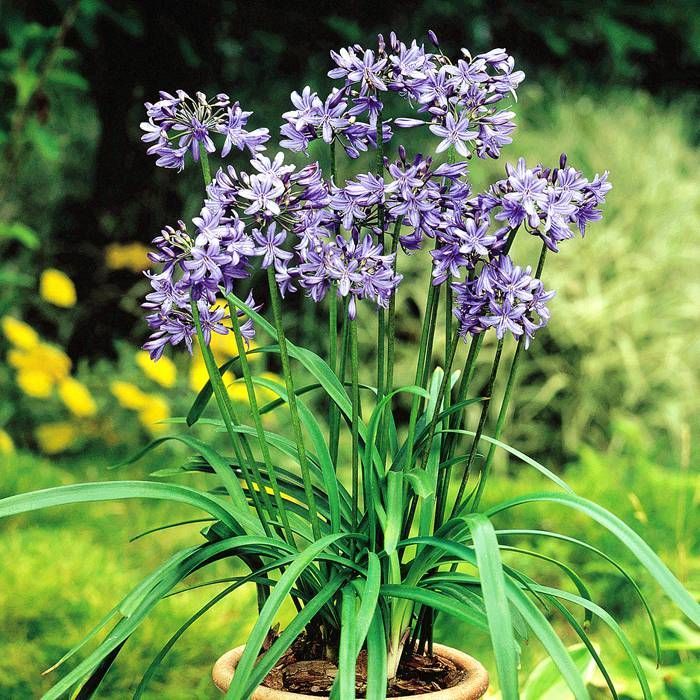Usual Agapanthus Issues and Exactly How to Resolve Them
Usual Agapanthus Issues and Exactly How to Resolve Them
Blog Article
Mastering the Art of Agapanthus Care: Important Steps for Healthy Development and Lively Blossoms
In the world of gardening, the cultivation of agapanthus stands as a gratifying venture for those that seek to nurture these stylish blooming plants. With their striking blossoms and graceful foliage, agapanthus has actually recorded the interest of garden enthusiasts worldwide. Nevertheless, achieving optimal growth and dynamic blooms requires a nuanced method that includes numerous crucial steps. From picking the best selection to mastering trimming strategies, the journey towards cultivating growing agapanthus plants is multifaceted and holds the vital to opening the complete capacity of these botanical gems.

Selecting the Right Agapanthus Selection

When selecting the best Agapanthus selection for your yard, think about elements such as climate suitability, bloom color, and development routine. Furthermore, take into consideration the climate in your region to ensure the Agapanthus variety you choose can prosper in your specific problems. Recognizing the development habit of various Agapanthus ranges is essential for proper placement within your garden.
Ideal Growing Problems
Taking into consideration the ideal ecological demands is important for effective Agapanthus cultivation. Agapanthus plants are sensitive to cool temperatures and ought to be protected from frost throughout winter months.
To make sure healthy and balanced development and vivid flowers, plant Agapanthus bulbs at a deepness of concerning 2-4 inches and area them 8-12 inches apart. Mulching around the base of the plants aids retain wetness and subdues weed growth.
Watering and Feeding Tips
Keeping correct wetness levels and giving essential nutrients are key elements in the treatment program for Agapanthus plants. When it involves sprinkling Agapanthus, it is crucial to strike an equilibrium. These plants prefer regularly wet soil but are at risk to root rot if overwatered. Throughout the growing season, water deeply as soon as a week, guaranteeing the dirt is well-draining to stop waterlogging. In hotter environments or throughout periods of dry spell, even more frequent watering might be required to maintain the dirt evenly moist. Nonetheless, lower watering in the winter season to avoid water logged conditions.
Fertilizing Agapanthus is essential for advertising healthy growth and prolific blooms. Use a balanced plant food, such as a 10-10-10 formula, in the very early spring as new development emerges. Repeat this application every 6-8 weeks throughout the expanding period. Avoid excessive fertilization, as it can bring about rich vegetation at the expenditure of blooms. Constantly adhere to the producer's directions for proper dilution and application approaches. By following these watering and feeding tips, you can guarantee your Agapanthus plants prosper and produce lively, resilient blooms.
Trimming Strategies for Agapanthus
Pruning Agapanthus plants at the ideal times and with appropriate techniques is essential for maintaining their health and wellness and promoting ideal growth and blooming. The optimal time to trim Agapanthus see page is in late winter months or early spring prior to new growth emerges.
Deadheading invested blossoms can likewise reroute the plant's power into producing more flowers instead than establishing seeds. If you desire to collect seeds for propagation, leave some flowers to mature and dry on the plant.
Bear in mind to make use of clean, sharp tools to make specific cuts and decrease the danger of presenting conditions. Agapanthus. Normal pruning will help keep your Agapanthus looking healthy and balanced and cool while making certain a plentiful display of beautiful blooms
Taking Care Of Common Parasites and Illness
After ensuring appropriate pruning strategies for Agapanthus, it is necessary to resolve common bugs and diseases that can impact the health and wellness and vigor of these plants. One typical parasite that impacts Agapanthus is the Agapanthus gall midget.
One more usual concern is fungal fallen leave area, which offers as dark sores on the fallen leaves. To protect against fungal conditions, make certain excellent air circulation around the plants, avoid overhead watering, and remove any contaminated leaves immediately. Furthermore, Agapanthus plants can struggle with origin rot if they are grown in inadequately draining pipes soil. To avoid this, plant Agapanthus in well-draining dirt and stay clear of overwatering. By being alert and taking punctual action versus conditions and bugs, you can help your Agapanthus plants prosper and generate vibrant blossoms.

Conclusion
Finally, understanding the art of agapanthus treatment includes picking the right range, offering ideal planting problems, proper watering and fertilizing, proper trimming methods, and attending to usual parasites and diseases. By following these vital steps, you can make certain healthy and balanced growth and vibrant blooms for your agapanthus plants. Bear in mind to consistently keep track of and preserve your plants to promote their total wellness and long life.
To ensure healthy and balanced growth and vivid flowers, plant Agapanthus light bulbs at a deepness of concerning 2-4 inches and space them 8-12 inches apart. By complying with these view it watering and feeding pointers, you can ensure your Agapanthus plants prosper and produce Visit This Link vibrant, durable blooms.
One typical parasite that influences Agapanthus is the Agapanthus gall midget. Furthermore, Agapanthus plants can experience from root rot if they are planted in badly draining soil. By adhering to these vital steps, you can make certain healthy growth and vibrant flowers for your agapanthus plants.
Report this page